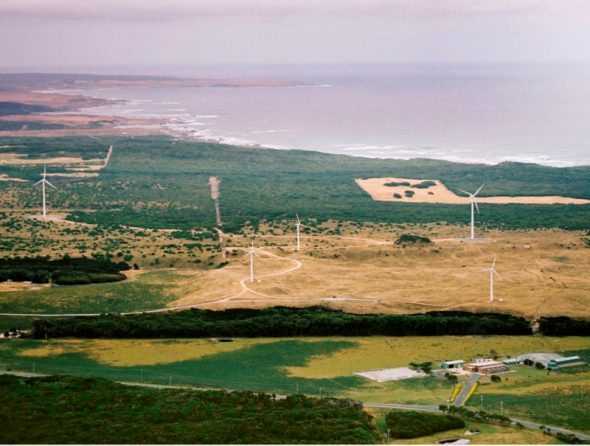Hydro Tasmania is hailing a major breakthrough with its King Island Renewable Energy Integration Project , saying it has achieved extended periods of 100 per cent renewable energy for the island’s grid – the first time that a grid of this scale has been serviced by wind, solar and storage devices.
The King Island project combines some 2.45MW of wind and a lot less solar power, with storage devices and an automated control system. The $46 million project has been funded by the federal Government and has been described as a potential insight into how Australia’s main grids can wean themselves off fossil fuels.
Project leader Simon Gamble says the major achievement so far has been the ability to switch off all fossil fuels completely for extended periods while variable renewable sources such as wind and solar are used. This is the first time this has been achieved for a load of this size (some renewable grids such as Pacific island of Tokelau’s are just 100kW is size), and the first time with predominantly wind power.
“This has removed a key barrier,” Gamble told RenewEconomy. Such systems had usually succeeded in turning down the amount of fossil fuel power needed, but not switching them off altogether. The full range of storage and control management systems have yet to be deployed.
“Achieving 100 per cent renewable energy penetration in large off-grid systems has remained elusive until now, and is very difficult to achieve given the need to maintain reliability and security of power supply under highly variable wind and solar conditions,” he said in an earlier statement>
The overall project aims to cut the use of diesel consumption on King Island by more than 65 per cent over a one year period, but it will allow diesel generators to be switched off when not required. So far it has achieved zero diesel operation for periods of up to 1.5 hours overnight when customer demand is lowest, and in daylight hours under high wind conditions.
Last year, Gamble told RenewEconomy that the project would provide an insight into how the Australian grid might look in a few decades – a combination of renewables backed up by dispatchable power and with storage solutions. “The NEM (National Electricity Market) is a much larger system, but it will have similar technical issues,” Gamble said then. “If we are integrating more wind, and solar, we need to learn how to do it.”
The project is using Hydro Tasmania’s own advanced automated control systems and dynamic resistor technology, coupled with a standard flywheel uninterruptible power supply system, commonly used in hospitals and telephone exchanges. Later this year, customer load control will be introduced, as well as a 3MW battery array from Ecoult, which is developing an enhanced lead battery known as the “UltraBattery” first unveiled by the CSIRO.
Gamble says this enables all diesel generation on King Island to be switched off more often when there is sufficient wind and solar power to meet customer demand. “The transition from diesel power station to 100 per cent renewables, and back again when and as required, is entirely automated and allows the station to achieve significant diesel savings while operating unstaffed.”
The project was to have installed more wind generation, but the closing down of the island’s major industrial site, the local abattoir, last October, caused a rethink. The peak load is around 2.3MW. The project will retain the 2.45MW current wind capacity (which is separate from the plans for a 600MW wind farm on King Island to export electricity to the mainland). It also has a 100kW solar PV array and a further 100kW of solar PV on the rooftops of island homes.
“Hydro Tasmania’s integrated solution ensures that rapid and unpredictable changes in sun or wind conditions don’t cause interruptions to power supply – even when these are the only source of generation available,” the company said in a statement.
“Although there are remote area power systems in some parts of the world that are capable of supplying the energy needs of single homes or small villages, this is the first remote system on this scale capable of supplying the power needs of an entire community, including industrial customers and an extensive distribution network, solely through wind and solar energy.
“Having established that zero diesel operation is possible, we are now looking to increase the duration for which we can operate in this mode.”
Hydro Tasmania is seeking to commercialise its off-grid energy solutions and export these to customers in Australia, and in due course to the Pacific and the South East Asia region.






